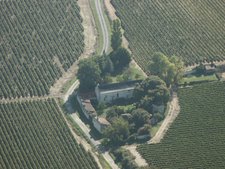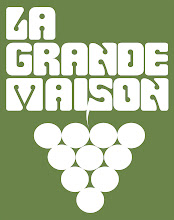How did that happen? We've been at La Grande Maison for 6 years now, as of yesterday. Where did the time go? There is always masses to do on the house to maintain it's state of 'arrested decay', a new window here, a chimney re-built there, potager to dig over and re-plant, endless guttering to re-new and rooms to re-furbish. Hah - all in a days work!
This week though we have been working on a new project for the caves and creating a new tasting room where we can sample some of the superb wines that the Loire Valley has on offer. Come on down and we'll give you a tour around.
In the 17th Century La Grande Maison was a fortified Wine Estate and owned all the vines in the surrounding area from which it produced it's wines. It was owned by Gilles Louis Antoine Aubert du PETIT THOUARS & Marie Gohin, Dame de Boumois and Arthenay who also owned Chateau Boumois on the south bank of the Loire near Saumur.
A bit of interesting history here. One of their sons, Arisitde Du Petit-Thouars participated in the American War of Independence 1779-83 and later sailed to Botany Bay, Australia in search of the lost French explorer La Perouse. He captained the ship The Tonnant in the campaign of Egypt with Napoleon Bonaparte but was killed in the naval battle of Aboukir on the 5th August 1798. During his time in the USA (c. 1794) Aristide Du Petit-Thouars was also involved in the construction of about thirty houses on a site called Azilum in Philadelphia. An enterprise promoted by the financier and Senator of Pennsylvania, Robert Morris. Amongst the buildings was one referred to as La Grande Maison, and later as “The Queen’s House”, in the hope that Marie Antoinette and her children would escape from France and come to occupy it.
A bit of interesting history here. One of their sons, Arisitde Du Petit-Thouars participated in the American War of Independence 1779-83 and later sailed to Botany Bay, Australia in search of the lost French explorer La Perouse. He captained the ship The Tonnant in the campaign of Egypt with Napoleon Bonaparte but was killed in the naval battle of Aboukir on the 5th August 1798. During his time in the USA (c. 1794) Aristide Du Petit-Thouars was also involved in the construction of about thirty houses on a site called Azilum in Philadelphia. An enterprise promoted by the financier and Senator of Pennsylvania, Robert Morris. Amongst the buildings was one referred to as La Grande Maison, and later as “The Queen’s House”, in the hope that Marie Antoinette and her children would escape from France and come to occupy it.
A second son, Aubert Du Petit-Thouars was obviously a bit more of a pacifist specialising in botany and a herbist of 2,000 exotic plants. He became Director of La Pepiniere du Route in Paris and was a member of the Academy of Sciences. It is said that he also sailed with his brother to Botany Bay in his exploration of plant life.
Another section of the tunnel and more wine!
So how come La Grande Maison has a pigeon tower? As a noble family of certain rank the du Petit Thouars' would have been allowed (with the permission of the crown) to build a 'fuye' or pigeon tower. This extends underground by some 10 metres and 7 metres above ground. The number of slots in the pigeon tower would have represented the hectarage of the vineyard in the 17c. A handy way of counting how much land you had when you came to pay your taxes. No wonder they hid it underground!
 The tunnel from the “fuye” leads to a spectacular wine cave where you can still see the remains of the old wine press and barrels.
The tunnel from the “fuye” leads to a spectacular wine cave where you can still see the remains of the old wine press and barrels.
 Many of the other tunnels have the names and dates of people who carved them out in the tuffeau walls where they might have been hiding during the 1st World War. This carving is from 1916.
Many of the other tunnels have the names and dates of people who carved them out in the tuffeau walls where they might have been hiding during the 1st World War. This carving is from 1916.
 The tunnel from the “fuye” leads to a spectacular wine cave where you can still see the remains of the old wine press and barrels.
The tunnel from the “fuye” leads to a spectacular wine cave where you can still see the remains of the old wine press and barrels. Many of the other tunnels have the names and dates of people who carved them out in the tuffeau walls where they might have been hiding during the 1st World War. This carving is from 1916.
Many of the other tunnels have the names and dates of people who carved them out in the tuffeau walls where they might have been hiding during the 1st World War. This carving is from 1916.













No comments:
Post a Comment